A Pandemic Year-In-Review: Our Public Health Response to COVID-19 in 2020

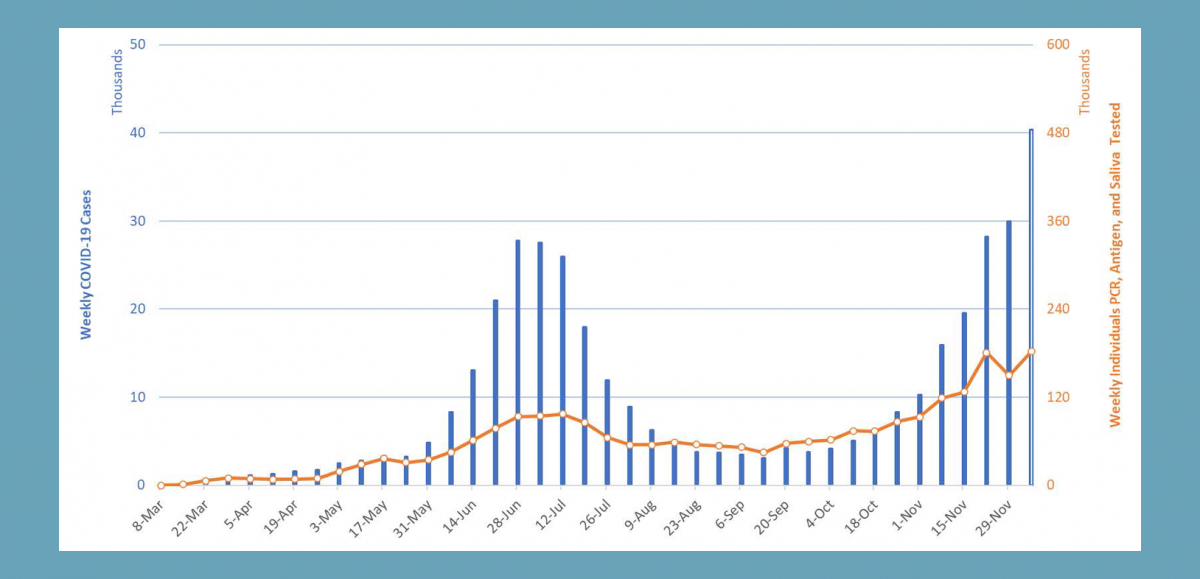
Arizona Positive COVID-19 Tests, March through November, 2020
Over the past nine months, the pandemic has changed our lives forever. At the same time, faculty, students, and staff from MEZCOPH have led the charge to fight the spread of the virus and support communities that have been most affected.
Looking back to March of this year, when COVID-19 first began to spread in Arizona, few of us could have imagined how the pandemic would transform our lives. Now, more than nine months later, we know that 2020 will be a landmark year, the year of COVID, the year that public health entered the headlines. From the beginning, our students, faculty, and staff have worked tirelessly to respond to the crisis. At the Mel and Enid Zuckerman College of Public Health (MEZCOPH), we have collaborated with our partners inside and outside the university to stop and slow the virus, we have worked to support our diverse communities in a time of need, and we have applied our expertise and energy to address the social and health disparities highlighted by the pandemic.
This is a year that has put us to the test, and we have risen to the challenge with compassion, dedication, and innovation. Our College community has done so much to fight COVID and we are amazed and proud when we look back at all we have accomplished. Thanks to the leadership team guided by Dean Iman Hakim, the College has adapted in so many ways, and at the same time launched initiatives to help the university, the Tucson region, and the state respond as effectively as possible to the pandemic. We also know there is so much more to be done, even with the first vaccines starting to arrive, and there is still a long road ahead before we reach the other side.
In this “year-in-review” we look back, month by month, at the many initiatives, projects, and campaigns we have implemented. We cannot look back at the year 2020 without recognizing the hundreds of times that our faculty members have shared their knowledge and expertise with the media – in interviews, letters, articles and videos – to help inform the public and guide our leadership with science in the fight to stop COVID-19 in Arizona.
March
The first case of COVID-19 was diagnosed in Arizona in late January, and by March the state was on alert, cases were rising, and K-12 schools shut down. The University of Arizona cancelled all in-person classes following spring break, and directed faculty and staff to work from home. This was a massive shift to online courses and work in a very short time, yet through the hard work of our staff at MEZCOPH, we were able to overcome the logistical challenges and move classes online.
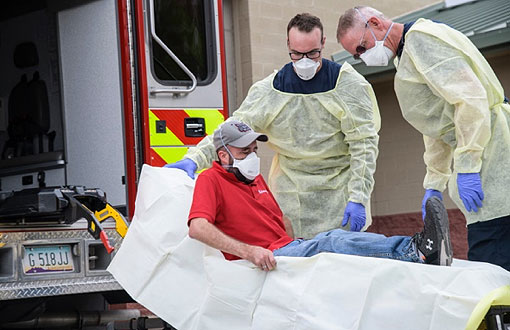
Members of the Tucson Fire Department worked with faculty from MEZCOPH to produce a training video for first responders
At the same time, our faculty and students were quick to respond. In collaboration with UA Global, many of our faculty provided their expertise for a COVID-19 Prevention Webinar for international partners. At the same time, Dr. Kelly Reynolds collaborated with the Tucson Fire Department to produce a training video for first responders to guide them in infection prevention practices. The video, posted by the Western Region Public Health Training Center at MEZCOPH, drew thousands of views on YouTube.
It was also in March that Dr. Joe Gerald began producing his weekly Arizona COVID-19 Data Modeling Report, a review of state data and all the predictive models based on that data. The models for Arizona are generated by various public health data modeling teams nationally, and Dr.Gerald compiles and analyzes them in his report. This weekly report has become a mainstay of COVID-19 data tracking and analysis for Arizona.
With kids stuck at home, and parents struggling to juggle work and childcare, Dr. Patricia Haynes led a team of faculty and students to develop a Toolkit for Parents, a portfolio of materials to guide parents and teachers on how to talk to kids about the COVID-19 outbreak.
The College also joined with regional healthcare providers and Pima County to produce a Public Service Announcement message for television in the effort to inform and assure the public that we were all working together to stop the virus. Meanwhile, public health student volunteers jumped in to answer phones for the AZ Poison Control Hotline phone system that had been converted to field COVID-19 questions as the public searched for answers.
At the end of the month, on March 30, Governor Ducey ordered schools closed for the rest of the year and issued a stay-at-home order to stop the spread of the virus.
APRIL
As cases of COVID-19 continued to climb slowly in Arizona, Dr. Kacey Ernst was a key member of the UArizona team that created the AZCOVIDTXT public health tool, a two-way texting system that gathers vital public health information from Arizonans, and also directs information and resources to those in need. At the same time, public health students from the SAFER team (Student Aid for Field Epidemiology Response) had begun to do Case Investigations for the Pima County Health Department. Other students found a way to deliver the annual Public Health Poster Forum and Keynote Panel “virtually” to highlight their research.
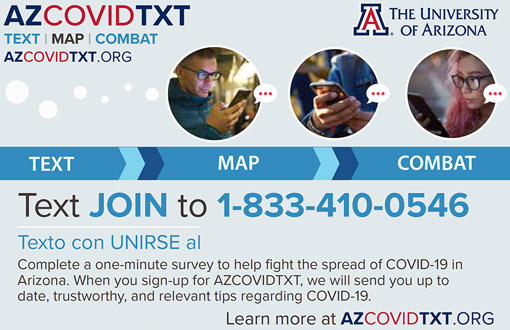
Learn more at azcovidtx.org
Looking ahead, leadership at the University of Arizona assigned Dr. Jeff Burgess as Chair to lead the UArizona Re-Open Working Group convened by Provost Liesl Folks to formulate a plan to reopen the university in fall 2020. Dr. Kate Ellingson, one of three CORE Team Members in the group, collaboratively spearheaded the first draft of the plan in frequent consultation with her colleagues in epidemiology. With the understanding that the health response along the US/Mexico border would also need expert coordination, Dr. Cecilia Rosales was a leading member of the team that organized the COVID-19 Response Along The US-Mexico Border – A Virtual Seminar Series. To reach underserved Spanish-language communities, the Mobile Health Units program from the College found a way to reach out virtually to provide guidance and information for constituents who were out of school, out of work, and unsure what to believe about the COVID-19 virus.
Concurrently, to provide the best public health expertise from the university and the College, the team at the Western Region Public Health Training Center launched a podcast series about topics and response measures related to the COVID-19 pandemic – Keeping Up With Public Health: Pandemic Response.
Meanwhile our faculty, even as they pursued pandemic response initiatives, were also receiving unprecedented media attention for their efforts. Dozens of media requests for expert comment arrived every week, and our faculty appeared in newspaper, radio, and television stories in both the Tucson and Phoenix markets, in addition to many stories in prominent national media outlets such as CNN, the New York Times, and the Washington Post. This groundbreaking level of media engagement only increased in the months that followed.
MAY
By the end of May, COVID-19 cases in Arizona had begun to rise more quickly, and public health experts were concerned. Circumstances in Arizona and around the country were changing quickly. Here at the University of Arizona, President Robbins was looking ahead, hoping to reopen the university in the Fall 2020 if a safe path forward could be found. Robbins appointed Dr. Richard Carmona, 17th U.S. Surgeon General, Distinguished Professor in MEZCOPH (and a MEZCOPH alumnus!), to lead the Reentry Task Force that would orchestrate the UArizona Test, Trace, Treat (3Ts) protocol for UArizona Reentry. In addition, President Robbins recruited Dr. Kate Ellingson, Dr. Kacey Ernst, and Dr. Cecilia Rosales, to help guide decisions for UArizona Reentry and lead some of the Reentry teams.
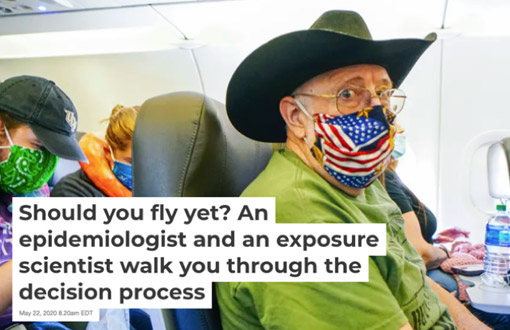
The most-read article ever for the UArizona
May also saw the publication of an article by Dr. Paloma Beamer and Dr. Kacey Ernst in The Conversation titled Should You Fly Yet?, about air travel safety during the pandemic. In the weeks and months that followed, the article was read by millions of people and picked up by other media outlets all over the country. It became the most-read article ever for the UArizona in The Conversation, an online magazine that publishes easy-to-understand articles by academic experts.
Meanwhile, our faculty in the College had already been applying for federal and state grants to fight COVID-19. Assistant Professor Leila Barraza, JD MPH and the Center for Rural Health received a grant to support rural hospitals in Arizona in the fight against the pandemic. More grants would follow from other faculty in the months ahead.
With schools closed, sports suspended, and teens confined at home unable to see friends in person, many teenagers were feeling lonely, bored, and frustrated. Two MEZCOPH graduate students worked with Dr. Patricia Haynes to produce two separate “How Do I Get Through This” videos, one crafted for Teenagers, the other oriented for Parents of Teens, to provide guidance and suggestions on how to manage the stress we all experience under stay-at-home policies.
It was also at this time that the College published the Workplace Reopening Guide, delivering the expertise of exposure scientists Dr. Paloma Beamer and Dr. Kelly Reynolds, and epidemiologist Dr. Kacey Ernst. The Guide provided direction for businesses in Tucson and Arizona that hoped to reopen safely with prevention measures. At this point in May, it was not yet understood how effective face masks would prove in stopping the spread of the virus, so the Workplace Reopening Guide later evolved to include face masks as more data emerged.
During this time, Pima County Health Department needed support, and public health student interns, guided by Emily Waldron, MPH, and the Academic Health Department at the College, provided that support in many forms, including infographics for safety communication.
Finally, at the end of May, after a semester where the entire university had pivoted to online-only classes within the span of a few weeks, the College hosted the Convocation for Spring 2020 for graduates as a “virtual” video event, sending a new generation of public health students to fight the spread of COVID-19 and become the leaders of tomorrow.
JUNE
By June, COVID-19 cases in Arizona were beginning a steep rise that would ultimately reveal itself to be a dangerous spike and put Arizona in the national spotlight. On June 5, Arizona hit the grim milestone of over 1000 deaths due to COVID-19. Soon the cities of Tucson and Phoenix imposed face mask mandates on June 18.
At the same time, protests about the brutal killing of George Floyd while in police custody swept the country, and these protests, combined with the clear health disparities illuminated by the pandemic, brought a new level of public awareness and outrage over issues of social justice and health equity. In response to the cultural moment, Dean Hakim published a statement reaffirming the College’s dedication to health equity and the struggle against systemic racism.
To better understand the virus, Dr. Jeff Burgess received $7.7 million in funding from the Centers for Disease Control (CDC) to lead a team of University of Arizona Health Sciences researchers for the AZ HEROES research study. The research project gathers data on COVID-19 immunity among essential workers across Arizona in order to better understand immune response and duration.
Following the success of the “Should You Fly Yet?” article in The Conversation, and with many Americans wondering about the safety of summer vacation, Dr. Paloma Beamer wrote another article for the online publication, “Is It Safe to Stay in a Hotel, Cabin, or Rental Home?” Also this month, public health PhD candidate Amanda Wilson worked with professor Kelly Reynolds, to conduct a research study on the efficacy of different materials for homemade face masks, in collaboration with researchers from the U.K. that was published in the Journal of Hospital Infection and received widespread media attention.
As part of the advance planning for the return of students to the University of Arizona in Fall 2020, and the “Test, Trace, Treat” (3Ts) strategy for a safe return, Dr. Kacey Ernst, Dr. Paloma Beamer, and Dr. Kristen Pogreba-Brown were working on the Arizona Covid Watch “exposure notification” app being developed by UArizona for smartphones in coordination with both Apple and Google. This Covid Watch app would become one of the first and most successful “exposure notification” apps, based on Bluetooth signals, to be deployed in the United States.
At the same time, Dr. Kacey Ernst was also working with another team from the university to develop the Wildcat Wellcheck text-based system for self-reported health tracking in coordination with Campus Health. This was another innovation tied to the “Test, Trace, Treat” strategy for the UArizona Reentry Plan.
JULY
COVID-19 cases rose at an alarming rate in late June and early July. Hoping for better conditions in the weeks ahead, President Robbins decided to focus on reopening in Fall 2020, and the UArizona reopening strategy grew from the continuing work done by MEZCOPH faculty.
Meanwhile, grants from the UArizona Office of Research, Innovation, and Impact (RII) enabled crucial research projects from the College. First, a study of the health and wellbeing of older UArizona employees led by Dr. Zhao Chen, a project now called the Saguaro Study, and second, a research study on the health and wellbeing of UArizona frontline employees led by Dr. Mona Arora. Meanwhile, with possible school reopening on everyone’s mind, Dr. Saskia Popescu was one of the co-creators of a color-coded Risk Index Tool for Schools as part of a story published in the New York Times.
AUGUST
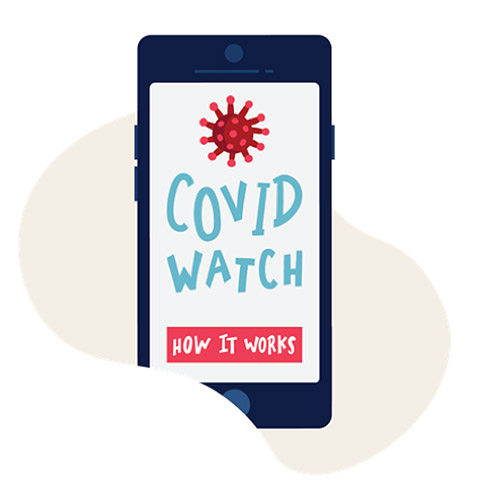
Covid Watch app being developed by UArizona
As the long hot COVID summer dragged on with record-breaking heat in Arizona, case counts in the state began to decline from their peak in July. All attention turned to the return of students, with the first day of classes scheduled for August 24, 2020. However, students started returning to the dorms two weeks before that, and widespread testing of students and staff commenced as part of the UArizona’s “Test, Trace, Treat” (3Ts) Reentry Plan.
As part of the 3Ts plan, the Arizona Covid Watch “exposure notification” app launched at the University of Arizona on August 19. Several MEZCOPH faculty and students worked on the development of the app.
To remind everyone in the College about their responsibility to keep the whole community safe from COVID-19, MEZCOPH leadership created the Safe Reentry Pledge for all students, staff, and faculty. The pledge helped promote positive health behaviors and attitudes around the College and across campus.
For months now, Dr. Joe Gerald’s weekly report on Arizona’s COVID-19 cases and data models had provided a backbone of solid scientific guidance for leadership at the university, in Pima County, and around the state. Hundreds of people continue to follow his reports, and he provides dozens of media interviews, including national media like the New York Times.
SEPTEMBER
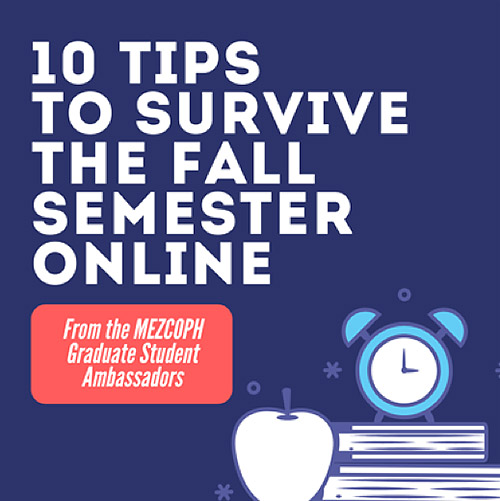
10 Tips to Survive the Fall Semester Online
With the return of thousands of University of Arizona students to campus dormitories and nearby private student housing, everyone was watching the rate of positive COVID-19 tests in the campus community. For the first few weeks the positive tests stayed low as other universities around the country opened and then quickly shut down when cases spiked. A few weeks into the semester, however, more positive tests popped up, and soon there was a surge in cases among students. At the time, almost all classes remained online only. Transmission was happening primarily when students socialized, and fortunately almost no faculty and staff were infected.
To stop the surge, President Robbins, Dr. Carmona and UArizona leadership worked closely with the city and Pima County to curb large social gatherings, promote face mask use, and enforce policies. Gradually, the surge subsided. During all this, the UArizona Contact Tracing team led by Dr. Kristen Pogreba-Brown and built from the core SAFER student team, worked closely with Campus Health and Pima County to interview individuals who had tested positive, warn contacts to get tested, and help track the spread in the campus community to inform a data-driven response.
In Pima County, K-12 students had also returned to school remotely and school districts faced many challenges. Student interns from the College helped Pima County Health Department support and guide the school reopening process. Other students found a way to deliver obesity prevention programming to middle school students online. MEZCOPH Graduate Student Ambassadors created a helpful guide to managing the semester online called 10 Tips to Survive the Fall Semester Online, and the College partnered with Arizona FORGE to create a Student Health Promotion Contest. Despite all the challenges, our faculty and students were still finding solutions, supporting each other and helping the community.
This was also the month that the College received full accreditation from the Council on Education for Public Health for seven more years, and the month when it became official that the fiscal year 2019-20 was a record-breaking year for MEZCOPH research funding with $26.6 million awarded from federal and state grants.
OCTOBER
In early October, the COVID-19 case counts remained low, but then they began to climb again towards the end of the month, along with case counts in the rest of the country. The university moved to Phase 2 of its Reentry Plan and began holding more in-person classes. This was also the month that MEZCOPH’s virtual 20th Anniversary celebration, 20 Days for 20 Years, kicked off on October 18. A series of digital stories about the growth and history of the College over 20 consecutive days, the 20 Days celebration highlighted how much we have accomplished in just 20 years.
Research from MEZCOPH faculty to better understand the virus and its impact on our diverse communities has now been underway for a few months, with the AZ HEROES research study in progress as well as studies on wellness for UArizona employees. In addition, a new collaborative research project including multiple investigators from University of Arizona Health Sciences, the Arizona CoVHORT research study, led by Dr. Kristen Pogreba-Brown, launched this month. The CoVHORT study is designed to better understand health risks before and after COVID-19 infection.
Through the UArizona Reentry process, key MEZCOPH faculty have been advising university leadership, and at this point the Public Health Advisory COVID Team (PHACT) meets weekly with President Robbins and top leadership to provide the best possible data-driven guidance to help the UArizona navigate successfully through the pandemic.
NOVEMBER

Covid Mythbusters campaign
Unfortunately, along with the rest of the country, COVID-19 cases in Arizona continued to climb in November, and hospitals were once again concerned that they would become overloaded with COVID patients. At the university, the worst had been averted, and most students stayed at home after they left for the Thanksgiving holiday. All UArizona classes were held online for the remainder of the semester. Nine months into the pandemic in Arizona, we had learned so much. By this time we understood the basic measures that could stop the spread of the virus, and yet infections were still rising due to misinformation, prevention fatigue, and social division.
Dr. Joe Gerald continues to publish his weekly COVID-19 data model reports, and the trajectory in November and today is cause for serious concern among public health leaders around the state. Following the election of Arizona’s new Senator, Mark Kelly, Dr. Gerald was picked for Kelly’s Transition Team to provide expert data advice on the spread of the virus in Arizona and the nation.
During November, the public health students on the SAFER Contact Tracing team continued to do their work, conducting case investigations and tracking down individuals who had potentially been exposed. Another student initiative, the Covid Mythbusters campaign on Instagram, co-produced by MEZCOPH graduate student Davina Dobbins, was featured on the College website in November. The Covid Mythbusters campaign had been running since August 2020, after Dobbins and her collaborator were among the winners of #SciCommMake, a communications competition for students to fight the spread of COVID-19 that took place in June.
An Unprecedented Year
From March to November, we experienced nine months that transpired so quickly, with so many changes. We navigated through a pandemic that has shown both how vulnerable we are in a deeply interconnected world, and at the same time has highlighted the power of public health.
It is indeed remarkable to look back and realize the many different ways that our faculty, staff, and students have responded to the pandemic. They worked to support all of our diverse communities as the crisis unfolded. They pushed for health equity and services in underserved communities, in tribal nations, and along the US/Mexico border. They launched research that will help us understand the effects of the virus on our health and wellbeing now and into the future.
Even as vaccine distribution begins, cases in Arizona continue to climb at an alarming rate that may soon overwhelm our healthcare systems. While we are deeply concerned about the spread of COVID during the holiday season, we continue our public health efforts with determination to make 2021 a safe and healthy year for all Arizonans.

